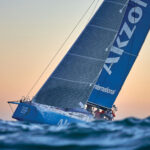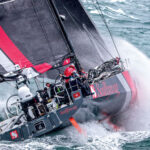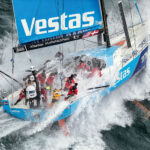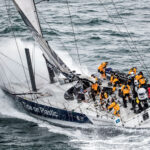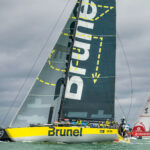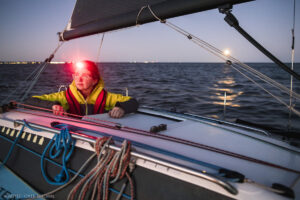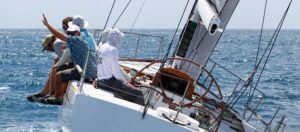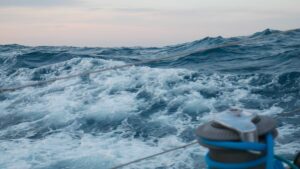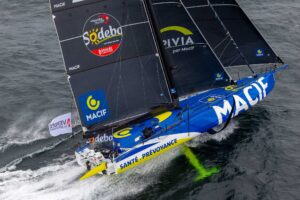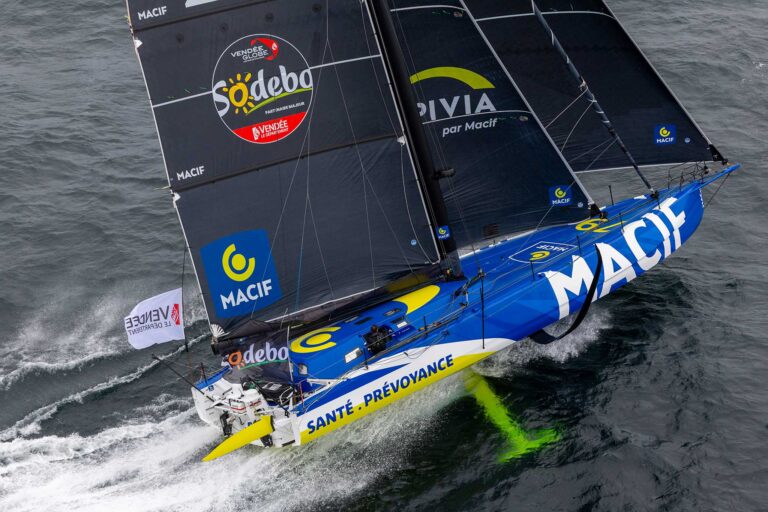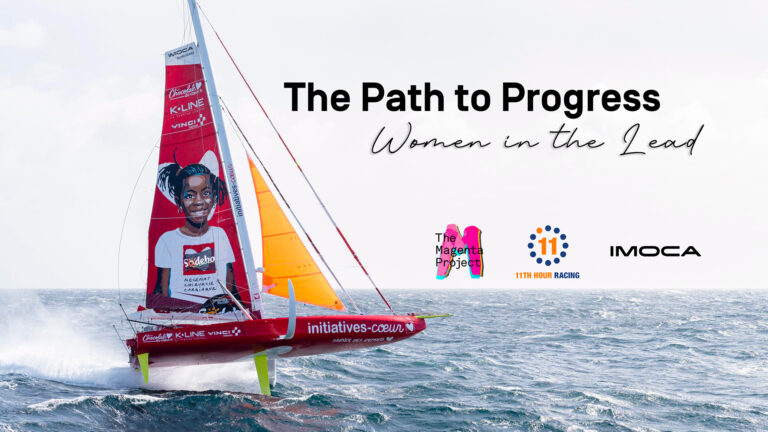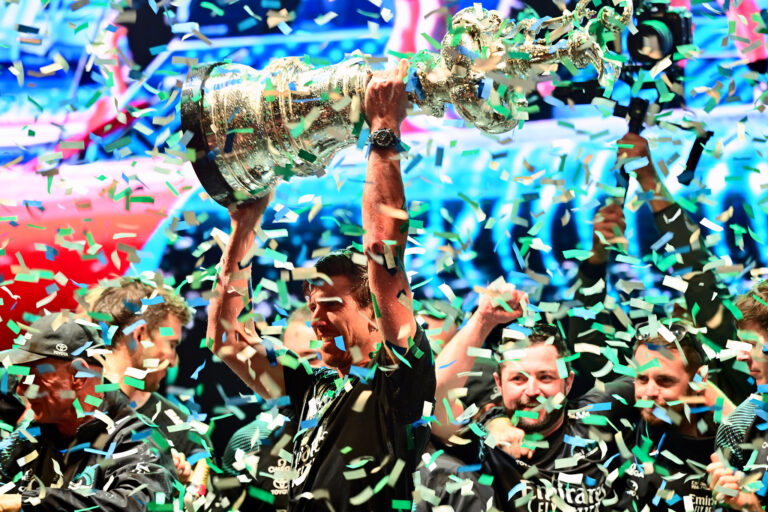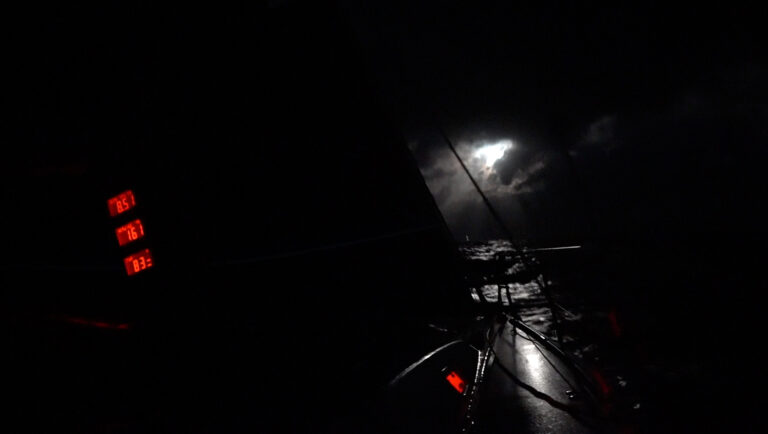
With offshore sailboat racing now entering the “appendage age,” the 2017-18 Volvo Ocean Race (VOR) may very well be the last great conventional monohull competition round the world.
In the future, the offshore classic is expected to see monohulls with lifting foils (much like in the most recent Vendée Globe) and inshore racing on multihulls, possibly eventually transitioning to offshore multihulls. This fall, however, the seven teams competing in the event will be sailing aboard the same Volvo Ocean 65 one-designs as in 2014-2015.
Which is not to say the race won’t still be plenty exciting, nor that it is standing still. First and foremost for U.S. VOR fans, the race is continuing to grow in significance here in North America: on the one hand, there will be the joint U.S./Danish-flagged effort Vestas 11th Hour racing, led by U.S. 2014-15 race veterans Charlie Enright and Mark Towill; on the other, the race will be making another stopover in Newport, Rhode Island, in late May, where it hopes to repeat the spectacular success it enjoyed in May 2015.

Beyond that, the VOR will also be spending more time in the Southern Ocean than it has in recent years—the same rugged body of water where it made its bones as the Whitbread. It is also experiencing a welcome surge in women’s participation. Oh, and thanks to its wealth of experience, there’s a good chance the aforementioned U.S./Danish team could win.
A Time to Change
With respect to those Whitbread roots, the 2017-18 race route includes a leg that goes directly across from Cape Town at the tip of Africa to Melbourne, Australia, without any more meandering through the Indian Ocean and the Middle East. The result will be a total of 12,500 miles of racing in the Southern Ocean, including an epic 7,600-mile leg from Auckland, New Zealand, around Cape Horn to Itajaí, Brazil, which looks to be especially exciting. Not only that, but scoring has changed to a high-point system and the two Southern Ocean legs, plus the North Atlantic leg from Newport to Cardiff, will all score double points.
Speaking of scoring, other changes are being made to encourage risk-taking and help spread out the fleet. With the change to a one-design format in 2014-15 and the use of AIS and radar to track the competition, suddenly there was very close racing with boats sometimes finishing only a few minutes apart after thousands of miles of racing. This came from a no-risk strategy with no one really wanting to break from the fleet: an efficient approach, but ultimately a boring one for sailors and followers alike.
To fix this, organizers have said there may be tracking and AIS blackouts so boats can break away in “stealth” mode and shake things up a bit. There may also be blackouts in the weather data provided so that navigators will have to make more of their own decisions. To further incentivize risk-taking, the winner of each leg will also gain a bonus, and there will be a bonus for the first team to round Cape Horn as well as a bonus for the team with the lowest total elapsed time overall in the race. The 10-race in-port series, which will be sailed at all stopovers except Melbourne, will remain the tiebreaker should any teams be tied on points at the finish.
Although the Volvo race has had sporadic women’s participation in recent times, with all-women teams taking part in 2001-02 and 2014-15, there has been little in terms of boat knowledge transfer from the veteran male sailors. VOR CEO Mark Turner subsequently saw a crisis looming in terms of women’s participation, with the race becoming an all-boys club this time around. As he put it: “In mid- 2016 there was no potential women’s team really advanced enough in the sponsorship battle to guarantee a race start, which meant there might not be an all-female team and in that case, there would be no women.”
To fix this situation, the VOR instituted a new set of rules under which any all-male team will have seven sailors—one fewer than in 2014-15—but crews with women sailors will have an overall increase in crew numbers. The resulting potential crew combinations include 7 all-male; 7 men and 1 or 2 women; 5 men and 5 women; 7 women and 1 or 2 men; and 11 women. (The numbers can vary from leg to leg.)
Obviously, seven men would struggle to compete against a larger crew, or crews, so most boats have added at least two women to their roster. Dee Caffari’s Turn the Tide on Plastic is even planning on a 5/5 mix. As a result, it is looking like more than 20 women will be taking part in this race, most of them with Olympic or previous VOR experience. At press time, the only boat that had not yet listed any women in its crew was the seven-man team of Hong Kong’s Sun Hung Kai/Scallywag. However, it was reported to be considering adding women to its roster as well.

The Keys to Victory
Prior to 2014-2015, the first team to start designing and building a custom boat had a clear advantage over those that began later, which meant all the campaigns were forced to start very early if they were ever going to make it to the start line. Crew selection also happened early as the teams struggled to get their new boats up to speed.
With the advent of one-design racing, however, teams can now enter the race much later: so much so that Team Sun Hung Kai/Scallywag received its boat just 16 days before the start of Leg Zero (a series of qualifying events clustered around the biennial Rolex Fastnet).
Naturally Team Sun Hung Kai/Scallywag will have to play catch up with, say, Chinese-flagged Dongfeng, which has a boat packed with people who sailed the last VOR and has now had another 175 days to further work out its maneuvers, boatspeed and angle crossovers for its new sail wardrobe. Similarly, Spain’s Mapfre received its boat in March, 149 days before the Fastnet race, and Vestas 11th Hour Racing received its boat 128 days in advance, during which time it sailed not one but two transatlantics. For its part, Britain’s Turn the Tide on Plastic received its boat 58 days before the start of the Fastnet, and Team Brunel took delivery of its boat only a day before Scallywag.
To make things worse for the newcomers, back when the first race stage went directly from Alicante, Spain, to Cape Town, those teams still on the learning curve only suffered on points in one leg. This time, however, they will suffer on two legs, as not much will be learned during the very short and mostly sheltered course through the Strait of Gibraltar from Alicante to Lisbon.
As for the crews themselves, the pool of experienced Volvo sailors is quite limited, and as you’d expect the veterans are in high demand with the early birds catching many of these worms. As a result, the boats have vast differences in their combined VOR experience. AkzoNobel’s crew, for example, has sailed a combined 25 races, Vestas 11th Hour Racing 24, Mapfre 19 and Dongfeng 18, while late starter Brunel has just 10 races among its crew, seven of them belonging to skipper, Bouwe Bekking. Scallywag, with just one 2014-15 crew, and Turn the Tide, with crew undetermined other than British skipper Dee Caffari and Kiwi boat captain Liz Wardley, who have three races between them, will be especially affected by this lack of experience. As two-time veteran Carolijn Brouwer, the principal helmsperson with the all-female 2014-15 Team SCA and now with Dongfeng, explains, you can only learn to drive in the Southern Ocean in the Southern Ocean—there’s simply nothing else like it in the world.Bottom line: expect Dongfeng, Mapfre, AkzoNobel, Vestas 11th Hour Racing and Team Brunel to duke it out at the front of the fleet, while it will be tougher going for Scallywag and Turn the Tide on Plastic.

Of course, the team of most interest to North American followers will be Vestas 11th Hour Racing, a veteran squad that in addition to Enright and Towill includes Britain’s Simon Fisher as navigator; U.S. sailor Nick Dana; Aussies Tom Johnson and Phil Harmer; Kiwi Tony Mutter; Irish sailor Damian Foxall; British sailor Hannah Diamond; and Danish Olympian Jena Mai Hansen. Discussing his chances in his second attempt at a VOR, Newport-based Enright said: “This is an American skippered and managed effort, with Newport-based 11th Hour Racing and Vestas as our main sponsors. You couldn’t ask for better partners. In the last race, on Alvimedica (which Enright also led with Towill) only one sailor, our navigator Will Oxley, was a previous race participant. By contrast, this time the crew has sailed in a total of 24 Volvo races. That will make an enormous difference to our performance.”
With respect to Leg Zero, which was still ongoing at press time, Enright added: “While the boat has done two Atlantic crossings, we haven’t all been on the boat together as a unit yet. I think the important thing is that we have the right people, which I think will always make the difference. In some positions, we have got guys who have won the last race in these boats. I would like to think of that as a no-excuses roster. We certainly try and surround ourselves with the best folks we can.”
Enright noted that for the Fastnet Race some crews were using old sails, others were using new canvas, and some were still trailing crew. As a result, he said, finish times should not be interpreted as a true guide to form in the VOR itself. “It’s not about peaking in August. It’s about improving throughout the course of the race and hopefully finishing on top in June,” he said summing up his take on the situation.
Back in the U.S.A.
Crew depth and odds-making aside, if there’s one thing everyone can agree on it is that the Newport stopover midway through the last running of the event was a tremendous success and that it will hopefully be even bigger this time around.
Back in 2015, at the end of the 5,010-mile passage from Itajaí, leg leaders Dongfeng and Abu Dhabi were scrapping for the win as they entered Narragansett Bay, and ultimately finished late at night separated by just three and a half minutes. An estimated crowd of 5,000 was on hand to bear witness, with some 2,500 still around at 0330 when Enright and Towill’s Team Alvimedica, the hometown favorites, finished.
Recently retired Volvo Ocean Race CEO Knut Frostad said after the Newport stopover, “I’ve been to an American stopover seven times now and can’t recall anything as good as this. We waited 42 years to come to Newport, and that was way too long.” Frostad added that the final visitor count (131,346) was four times that of the previous North American stopover in Miami for the 2011-12 race.
Finally, after getting off to a slow start, it looks like the 2017-18 race will once again have a healthy-size fleet that should make for close, exciting racing without overtaxing the efforts of race organizers.
“Seven great teams, diverse in their approach, nationalities, types of sponsor, but united by their obsession to win the Volvo Trophy, all make for a strong event,” said CEO Mark Turner late last summer. “One surprise in the past weeks has been the steady flow of high-quality crew announcements, of a depth and caliber that has perhaps not been seen for several editions: from veterans returning to the race after a few editions absence, to Olympic medalists dipping their toes offshore for the first time and America’s Cup sailors coming straight from Bermuda.”
“It’s great to see U.S. sailors Charlie Enright and Mark Towill kicking off again,” Turner added, “along with quite a few companies backing teams with the U.S. market as part of their objectives. Vestas itself being a great example, but AkzoNobel and others too.”
All of which is great news for U.S. race fans. Over the years, the center of gravity for grand prix offshore racing seems to have been drifting farther and farther from American shores: with France obviously ground zero for shorthanded offshore sailing, and the America’s Cup going to New Zealand after having been held into Bermuda.
The VOR, however, has developed ties to North American that are not only long-lived but stand a good chance of becoming even stronger in the future. Let’s hope that trend continues, and good luck to all the sailors taking part in of one of the world’s great sailing adventures.

How to Watch the 2017-18 VOR
Over the years, the Volvo Ocean Race has been at the forefront when it comes to making it possible for shorebound fans to follow their favorite teams, and the 2017-18 edition will be no different.
Once again, each boat will carry an onboard reporter, although, in contrast to years past, these reporters will be switched around from boat to boat as the race progresses. VOR organizers will also be broadcasting an 11-part television series as well as providing live internet broadcasts of each start, finish and inshore race. Go to volvooceanrace.com for details.
SAIL magazine, in cooperation with Musto, will also be offering real-time coverage and analysis through a series of dedicated e-blasts and it’s daily e-newsletter. Go to sailmagazine.com/racing/volvo-ocean-race for more information.
Based in Spain, Rob Kothe is a long-time Olympic and grand prix sailing journalist, and the founder of the sailing news network Sail-World.com
October 2017

